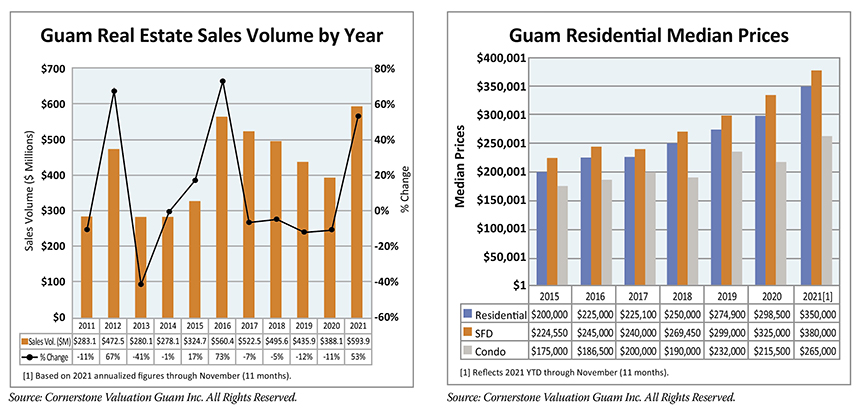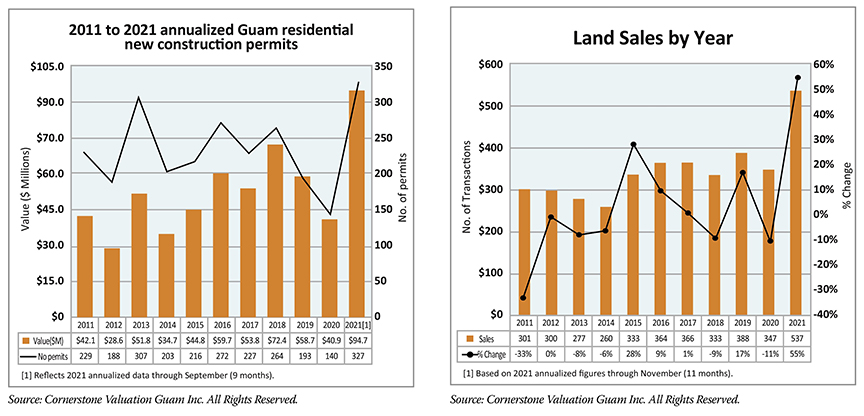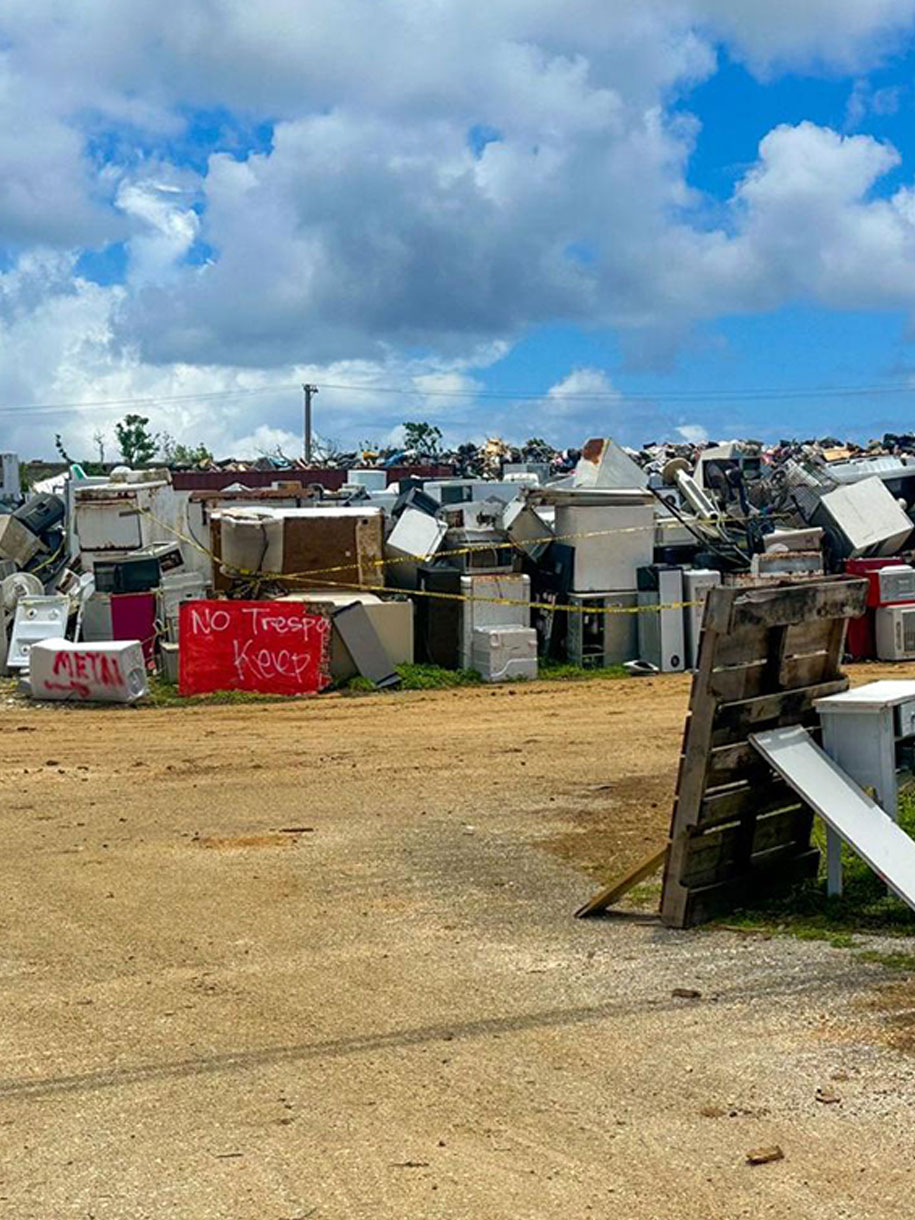
President
Cornerstone Valuation Guam Inc.
As the saying goes, the house you looked at today and want to think about until tomorrow may be the same house someone looked at yesterday and will buy today.
This held true for many transactions in Guam in 2021. The limited supply, low interest rates, and high demand for Guam real estate — from local and off-island investors — has boosted the median prices.
The single family dwelling median price was at $380,000 in 2021, with four years of double-digit growth. We’re not unique in this situation as the fear of high inflation moves investors to the ubiquitous hedge against inflation. Local investors were the most active participants in 2021, buying land and improved properties alike. Despite an almost complete lack of large transactions (the largest transaction was the purchase of the Bank of Hawaii building in Hagatna at $6.75 million), the annualized sales volume for 2021increased by more than 50% compared to 2020 and was the highest in the past decade.
The two underlying issues that remain are skyrocketing construction costs and the tedious permitting process, preventing new supply from coming into the market.
Military-related projects with high dollar budgets, timely payments, and reasonable scheduling absorbed the capabilities of construction companies in Guam, leaving the private sector and Government of Guam projects behind. Guam Department of Public Works Director Vince P. Arriola noted during the Guam Chamber of Commerce’s Economic Forecast on Dec. 4 that there is $500 million in DPW infrastructure projects waiting for construction. This figure is expected to grow with the U.S. infrastructure bill — the Build Back Better America Act.

The federal government’s speedy approvals to allow construction projects in Guam (inside and outside “the fence”) have essential H-2 workers will ease this pressure.
Materials costs are also rising, coupled with supply chain disruption.
As expected, new construction methods are being explored, and in one particular case the old ones are back. One of our clients is bringing back the glory of the Quonset Hut with 225 mph wind resistance, four feet concrete base, insulation, and metal sliding doors — taking only three months to erect.
Multi-family residential rental rates increased significantly along with two major increases on the subsidized Guam Housing and Urban Renewal Agency rental rates in June and November 2020. It’s almost impossible to provide affordable housing without government policy and financial assistance. The Low Income Housing Tax Credit added only very limited numbers annually to the supply. A more natural growth, enabling local residents to build their own affordable housing, requires subsidies or fast track permitting.
The commercial market — despite what appears to be a healthy level of physical occupancy — suffers from economic vacancies where tenants can’t afford to pay rents.
Owner-occupant buyers are waiting for these properties to come onto the market. Restaurants and bars appear to be in demand, partly to replace those that went out of business and ramping up to the return of normalcy.
The industrial market is affected by supply chain woes. Similar to the U.S. mainland, cold storage construction, which has not occurred on-island for some time, has been on the rise. Self-storage properties experienced high occupancy resulting in increasing rates and more facilities in the pipeline.
As you can tell, I am highly anticipating the return of the Quonset Hut, which can provide fast relief for additional warehousing spaces. Data centers and life sciences* are the new sectors expecting growth and demand in the mainland, and the same is true in Guam. Industrial land is still abundant, along with the return of various former federal excess lands in parts of the island.
The Route 3 vicinity — which is in close proximity to Marine Corps Base Camp Blaz and Tumon — continues to grow. An industrial park, medical offices, power plants, housing, apartments, retail properties, mixed uses, barracks, and resort developments are all being proposed or under construction on this Dos Amantes Planning area.
What pandemic? This seems to be the question in the minds of resort-related developers when it comes to planning. Tumon land is still attracting investors. The Guam Land Use Commission is busy scheduling public hearings. Yet whether or not these mega projects get to be built still remains to be seen. Guam saw many GLUC approvals that did not translate to construction in the late 1980s/early 1990s of the Japanese bubble economy and in 2007/2008 due to the military buildup hype.

Any meaningful return of tourism is not expected any time soon. Who knows how many more variations of COVID will still come along?
Like all trials in life, what can’t kill you will make you stronger. In all fairness, most real estate investors and business owners must overlook the gloomy cloud of the next 12 to 18 months and continue to plan. I was discussing the paradigm shift with a couple of buyers who just paid new record prices for a couple of apartment buildings. They targeted new market segments, comparing the cost of new construction versus renovation as the justifications. Shift or be left behind.
The year 2022 will be an interesting year to watch as investors position themselves for the return of tourism, as well as the opening of the proposed Marine base and the civilian jobs it will bring. As far as real estate investment, and other things in life, like Mr. Warren Buffett always said, “Focus on quality. It’s far better to buy a wonderful property at a fair price than a fair property at a wonderful price.”
*Life sciences refers to solutions support facilities, labs, manufacturing space, and critical environments for a broad range of companies, including the pharmaceutical industry, contract research organizations, biotech firms, contract manufacturing organizations, medical device companies and the genomics industry.



 facebook
facebook
 Whatsapp
Whatsapp





